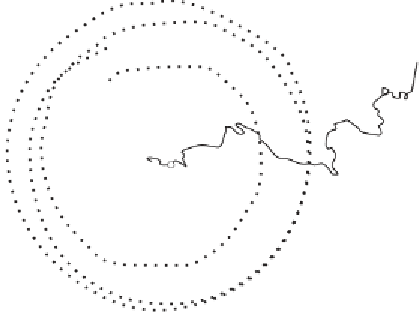Geoscience Reference
In-Depth Information
-0.2
1900.0
1996
1995.0
1998.5
1997
+0.6
+0.4
+0.2
y ['']
1997.0
1998.0
+0.2
x ['']
Fig. 5.13. Polar motion: mean pole displacement 1900-1997 (solid line),
detailed polar motion 1995-1998 (dotted line)
Geodesy and Geophysics, continuously observes the variation of a number of
parameters at a considerable number of stations distributed over the whole
earth. Thus, it monitors variations of the earth's axis (polar motion) and of
its angular speed of rotation.
The results are published as the rectangular coordinates of the instanta-
neous pole
P
N
with respect to a mean pole
P
0
N
. The astronomically observed
values of Φ
,
Λ, and
A
naturally refer to the instantaneous pole
P
N
and must,
therefore, be reduced to the mean pole, using the published values of
x
and
y
.
This is accomplished by means of the equations
Φ=Φ
obs
−
x
cos
λ
+
y
sin
λ,
Λ=Λ
obs
−
(
x
sin
λ
+
y
cos
λ
)tan
ϕ
+
y
tan
ϕ
Gr
,
(5-103)
A
=
A
obs
−
(
x
sin
λ
+
y
cos
λ
)sec
ϕ.
Now Φ
,
Λ
,A
are referred to the mean pole; these values are used in geodesy
because they do not vary with time. Longitude, throughout this topic, is
reckoned positive to the east, as is usual in geodesy; it should be mentioned
that in the past literature these formulas are often written for west longi-
tude, according to the former practice of astronomers. Since the correction
terms containing
x
and
y
are extremely small (of the order of 0
.
1
), we may
use either the ellipsoidal values
ϕ
and
λ
or the astronomical values Φ and Λ
in these terms. The term containing
ϕ
Gr
(the latitude of Greenwich) in the
formula for Λ is usually omitted, so that the mean meridian of Greenwich re-
mains fixed as the conventional
zero meridian
, rather than the astronomical
















